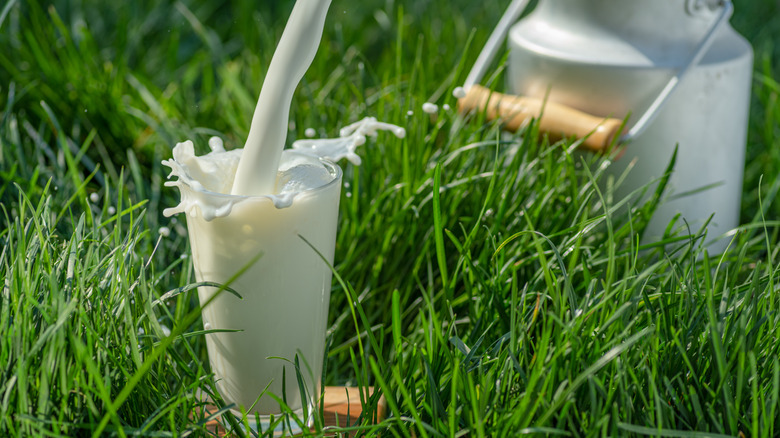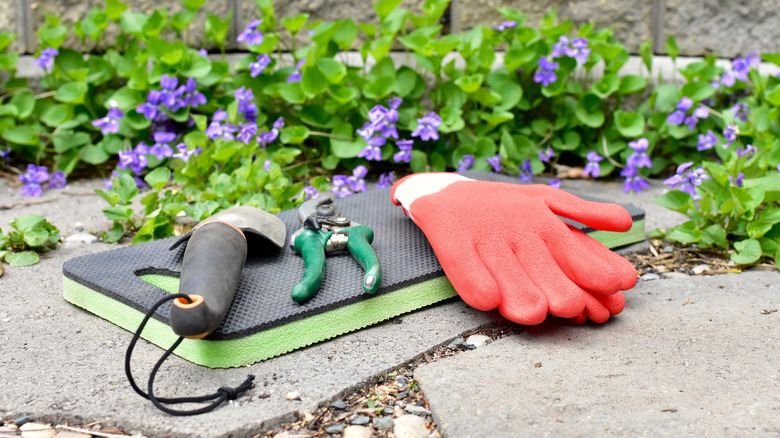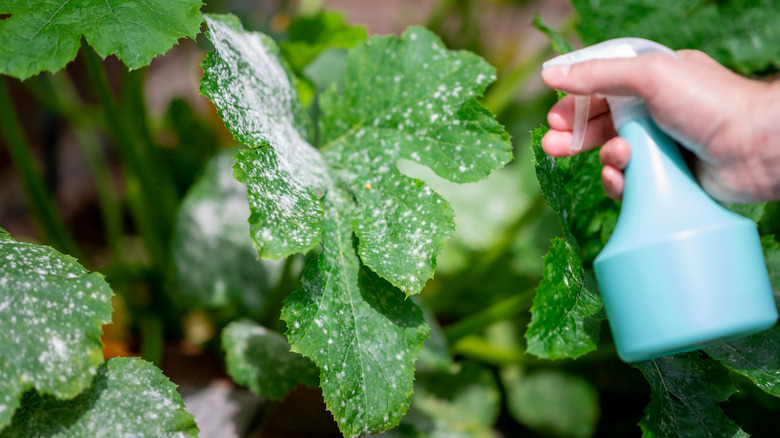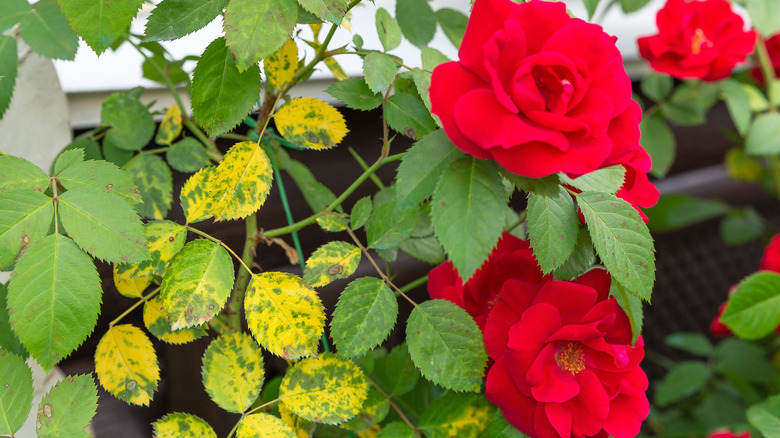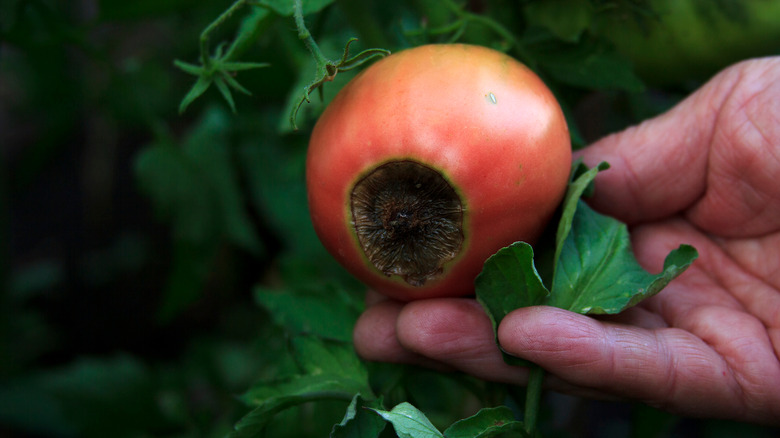5 Creative Ways To Use Milk In Your Garden
Millions of people discovered — or rediscovered – gardening in the past few years thanks to COVID lockdowns, and according to The Guardian, the trend hasn't simply disappeared as the world has opened up. According to Good Morning America, as prices have risen with inflation, more Americans are finding ways to save on their grocery bills by growing their own produce. However, gardening supplies aren't immune from the impacts of supply chain issues and fuel cost increases (via Spectrum News).
Here's the good news, you probably are overlooking an amazing, multipurpose gardening ingredient that, if used the right way, can reduce your reliance on specialist additives, amendments, and chemicals. It contains natural sugars, Vitamin B, and Calcium, and is packed full of beneficial proteins, as well as having disinfectant and antifungal properties. That's right — we're talking about milk.
Liquid milk is in 94% of households in the United States (according to Center for Dairy Excellence), so if you aren't already using milk in your garden, you can probably start today for free! Keep scrolling to find out how you can make use of this untapped resource to grow better, healthier plants for even less money than before.
Milk as a general fertilizer
Appropriately, the story of modern scientific research into using dairy products for fertilizer began with a dairy farmer. According to Successful Farming, Nebraska dairy farmer David Wetzel's herd was producing over 600 gallons of excess skim milk every other day as his focus was on high-fat creams and cheeses. In order to get rid of this overflow, he sprayed one of his pastures with it. Quickly his cows, then himself, and then researchers from the University of Nebraska began to take notice of the improvement in the quality of the milky pasture.
Dairy farmers and off-grid growers now sing the praises of natural enzymes and bacteria in raw skim milk for soil microbes, but home gardeners needn't worry about accessing pure, uncut milk. According to research published in the Journal of Soil Science and Plant Nutrition, a soil-amendment powder made only from expired dairy products caused a distinctive improvement in soil quality and crop growth.
In order to make your own milk-based fertilizer to use at home, mix equal parts of milk and water in a bottle, explains E Times. You can use regular 2%, skim milk, powdered milk, or even spoiled milk. The important things to avoid are anything that has added sugar or high-fat content. This mix can be applied to leaves or to the soil.
Milk as a disinfectant for garden tools
Many of the ways in which we interact with dairy are about controlling if and how it rots. Pasteurization, UHT treatment, and even cheesemaking are all about sterilizing or inoculating milk, and even the position of your milk in the fridge can make a difference in how long it stays viable, according to Metro. All of this messaging about milk's susceptibility to going bad might make it seem counterintuitive that milk could actually be a useful tool for disinfection, but the fact is, it's very effective.
According to Michigan State University, soaking gardening tools in a 20% solution of diluted dry milk powder for one minute was effective in preventing viral diseases from spreading from plant to plant via the tools being used. When compared to typical disinfectant products such as bleach, a diluted milk solution is far less toxic to gardeners, and is also less corrosive, per Cape Gazette.
The long-term implications of using dried milk as a garden tool disinfectant are effective viral control, better gardener health, less chance of accidentally poisoning any of your plants, and extending the life of your tools — surely a switch worth considering for any grower.
Milk for treating mildew
There are several common garden ailments that milk is especially effective at fighting. The first one is powdery mildew (sphaerotheca fuliginea), which is a fast-growing fungus that often infects cucurbits (zucchini, cucumbers, and pumpkins), as well as species of grape and rosemary (via GrowVeg).
According to GrowVeg, powdery mildew exists as spores in the air until it finds a suitable host plant. It lands on the leaves of the plant, grabbing on with root-like structures before growing a fuzzy or powdery white layer over the top layer of the leaf. This shades out the plant's cells from the sunshine it needs to live, as well as getting in the way of the leaf's gas exchange systems. It also then spreads rapidly from leaf to leaf, so it can very quickly take a healthy plant and put it in serious strife.
Before the turn of the century, the only scientifically proven method for tackling powdery mildew was to use chemical fungicides — however, a 2000 study published in the journal Trends in Plant Science found that spraying infected leaves with diluted dairy powder was both faster and more effective at reducing the area of leaves impacted by powdery mildew. According to Growing in the Garden, although the exact mechanism isn't yet understood, it appears that milk spray interacts with sunlight to fight the fungus, so be sure to spray when it's sunny!
Milk for treating rosebush black spots
This next use for milk in the garden is directly applicable to humanity's most popular flower — the rose (via Gardenstead). Black spot is an endemic fungal disease found wherever roses grow. Per Iowa State University, the best conditions for black spot growth are temperatures from 75 to 85 degrees Fahrenheit and high humidity. The fungus appears as black spots on the leaves of the rose plant, eventually turning the leaf a sickly yellow color and then causing it to die and drop off the plant. This can significantly inhibit plant and flower growth, and the fungus can rapidly spread from one leaf to the entire plant, as well as crossing over to nearby rose plants. Affected plants will also find it harder to survive the next winter.
Limiting humidity levels, removing fallen leaves, and planting fungus-resistant cultivars are all sensible ways of avoiding black spot. However, if you are already affected, a solution of one part milk and two parts water is effective at removing and preventing the spread of black spot in roses. According to A Garden for the House, each week, simply spray both the top and bottom of the leaves for resistance to black spot — and also, apparently, deer.
Milk for treating blossom end rot
Milk is also a fantastic help with one of the most common issues facing tomatoes — America's second most popular vegetable (via USDA). Unlike mildew or black spot, blossom-end rot isn't caused by an external infection, but by poor growing conditions that milk is uniquely suited to address. According to Almanac, blossom-end rot is a dark, sunken, or flattened patch of growth that appears at the bottom of the fruit furthest from the plant (where the blossom was previously attached, hence the name).
Per RHS, blossom-end rot is caused by a calcium deficiency in the affected fruit. Calcium is crucial for cell structure in plants and is usually found in abundance in soil. However, the blossom end of the fruits is just about as far from the roots as it's possible to be. If you are growing in a container, or in soil that is otherwise less than perfectly moist and draining, then plants can struggle to transport enough calcium all the way from root to fruit — all of the stem and leaf cells en route end up taking the calcium before it makes it to the fruit.
This means adding milk to the soil might not be the solution you require — however, applying a diluted milk solution to the leaves gives them access to more calcium than they need. Boosting your tomatoes' overall calcium levels like this once a month can be enough to remedy blossom-end rot, according to Garden Culture Magazine.
